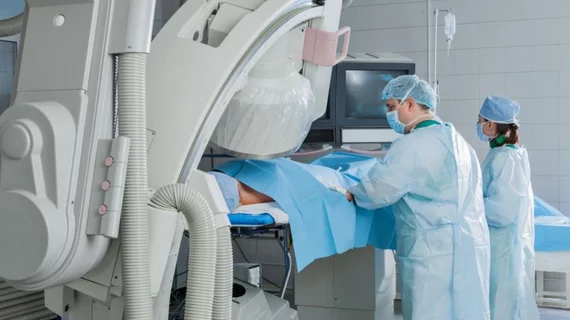A new analysis from the PROMISE trial suggests CT angiography (CTA) may be a superior front-line diagnostic test for patients with diabetes and symptoms suggestive of coronary artery disease (CAD).
In fact, compared to diabetics with stable CAD symptoms randomized to functional stress testing, those who underwent CTA experienced a significantly lower rate of cardiovascular death or myocardial infarction at two years (2.6 percent versus 1.1 percent). Clinical outcomes weren’t significantly different based on the initial testing strategy for nondiabetic patients.
The authors noted patients with diabetes had a higher burden of cardiovascular comorbidities and were more likely to be referred to invasive coronary angiography. They were also more than twice as likely to be taking statins, 50 percent more likely to be taking aspirin and almost four times as likely to be on an angiotensin-converting enzyme inhibitor/angiotensin receptor blocker 60 days after study enrollment.
Overall, the analysis included 1,908 patients with diabetes and 7,058 without diabetes. Among the 972 diabetic patients who underwent stress testing, 73 percent had a nuclear scan, 19 percent had an echocardiogram stress test and 8 percent had an exercise electrocardiogram.
“By enabling a visualization of nonobstructive CAD, CTA identifies additional at-risk patients and provides superior prognostic and discriminatory information when compared with functional stress testing,” wrote lead author Abhinav Sharma, MD, and colleagues in the Journal of the American College of Cardiology. “As the overall risk of subsequent CV events among stable contemporary patients with symptoms suggestive of CAD is low, the increased use of established cardioprotective therapies (as clearly influenced by CTA findings) would likely impart a greater magnitude of benefit among patients enriched for CV events—such as those with diabetes.”
Sharma et al. noted “CTA may be considered as the initial diagnostic strategy” in the diabetic subgroup, whereas the test choice is “less clear” patients without diabetes but symptoms suggestive of CAD.
In a related editorial, two researchers agreed the higher use of cardioprotective medications among diabetic patients randomized to CTA likely explained their lower event rates.
“While increased targeted early referral for invasive coronary angiography and revascularization may have also contributed, taken within the context of the highly limited existing evidence for improved outcomes with coronary intervention in stable chest pain, we suspect medical therapy played the larger role,” wrote Michael J. Blaha, MD, MPH, with Johns Hopkins University; and Miguel Cainzos-Achirica, MD, MPH, with Bellvitge University Hospital and Bellvitge Biomedical Research Institute in Barcelona.
The editorialists said the small number of MI or cardiovascular death events among diabetics—10 in the CTA arm and 25 in the stress testing arm—limited the power of the analysis and warrants caution when interpreting the results. They also added baseline cardiovascular risk, not diabetes status alone, likely impacted the observed differences in outcomes.
Nevertheless, Cainzos-Achirica and Blaha said the study “adds to a growing body of high-quality, high-impact evidence suggesting a preeminent role of coronary CTA for the assessment of patients with new-onset chest pain of suspected coronary cause.”
The U.K.’s National Institute for Health and Care Excellence (NICE) guidelines now recommend CTA as the most cost-effective option for an initial diagnostic test in this setting. Blaha and Cainzos-Achirica believe the next set of American guidelines should follow suit.
“Emphasis should first be on the proper clinical evaluation of the patient, recommending selective use of noninvasive testing only when symptoms are likely to be cardiac in origin,” they wrote. “Importantly, in those requiring testing, emphasis should be placed on coronary CTA as a first-line test, with explicit guidelines for appropriate use of preventive therapies matched to the visualized burden of coronary atherosclerosis.”

